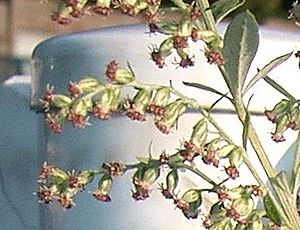Artemisia princeps facts for kids
Quick facts for kids Artemisia princeps |
|
|---|---|
 |
|
| Scientific classification | |
| Genus: |
Artemisia
|
| Species: |
princeps
|
| Synonyms | |
|
|
Artemisia princeps, also known as Yomogi or Japanese mugwort, is a plant from Asia. It belongs to the sunflower family. You can find it growing naturally in China, Japan, and Korea.
This plant grows back every year and can reach up to 1.2 meters (about 4 feet) tall. It spreads very quickly using underground stems called stolons. Because of this, it can sometimes grow where it's not wanted. Artemisia princeps has small, light brown flowers that bloom from July to November. These flowers have both male and female parts and are pollinated by the wind. Its leaves look like feathers, have wavy edges, and are light green. The underside of the leaves is covered with soft, white fuzz.
Contents
Where Does Mugwort Grow?
Artemisia princeps is originally from China, Japan, and Korea. It has also been brought to countries like Belgium and the Netherlands. This plant can grow in many different places. You might see it along roadsides, on hillsides, in valleys, or near riverbanks.
How People Use Mugwort
People use Artemisia princeps in many ways, especially in cooking and traditional medicine.
Cooking with Mugwort
The leaves and young shoots of mugwort can be eaten raw or cooked. Some people use them in salads or soups. They often remove any bitterness first.
Mugwort in Japan
In Japan, this herb is very popular. It is used to add flavor to special glutinous rice dumplings called kusa mochi or yomogi mochi. It also flavors rice flour dumplings known as kusa dango. Young mugwort leaves are often lightly boiled. Then, they are pounded and added to these treats. This gives the food a nice color, smell, and taste. Because of this use, the plant is also called mochigusa (meaning "rice cake herb"). Japanese people living in Hawaii also grow this plant to make herbal mochi.
Sometimes, mugwort leaves are quickly boiled and added to soups or rice dishes in Japanese cooking.
Mugwort in Korea
In Korea, mugwort is called ssuk (쑥). It is widely used in Korean cuisine and in traditional Korean medicine. In spring, when the young leaves are ready, they are used to make many savory dishes. These include jeon (Korean-style pancakes), ssuk kimchi, and ssukguk (a soup made with ssuk).
Most often, fresh mugwort or dried, ground leaves are added to different types of tteok (rice cakes). Today, ssuk also adds flavor and color to modern desserts and drinks. You can find it in ice cream, breads, cakes, mugwort tea (ssukcha), and ssuk latte.
Mugwort in Medicine
Artemisia princeps is a type of mugwort used in a traditional medical practice called moxibustion. This practice is common in China, Korea, Mongolia, Tibet, Nepal, and Vietnam.
Mugwort in China
In China, this plant is known as huanghua ai (黄花艾). This name means "yellow-flower mugwort."
Mugwort in Culture
In Korea, mugwort is called ssuk (쑥) or tarae ssuk (타래쑥). It plays an important role in the Dangun Sinhwa, a famous legend about the first Korean kingdom, Gojoseon. For ancient Koreans, ssuk was seen as a food with special healing or spiritual powers.
In the story of Gojoseon's founding in 2333 BCE, a bear was able to turn into a woman. This happened after she ate only 20 cloves of garlic and a bundle of ssuk for 100 days.
See also
 In Spanish: Artemisia princeps para niños
In Spanish: Artemisia princeps para niños






